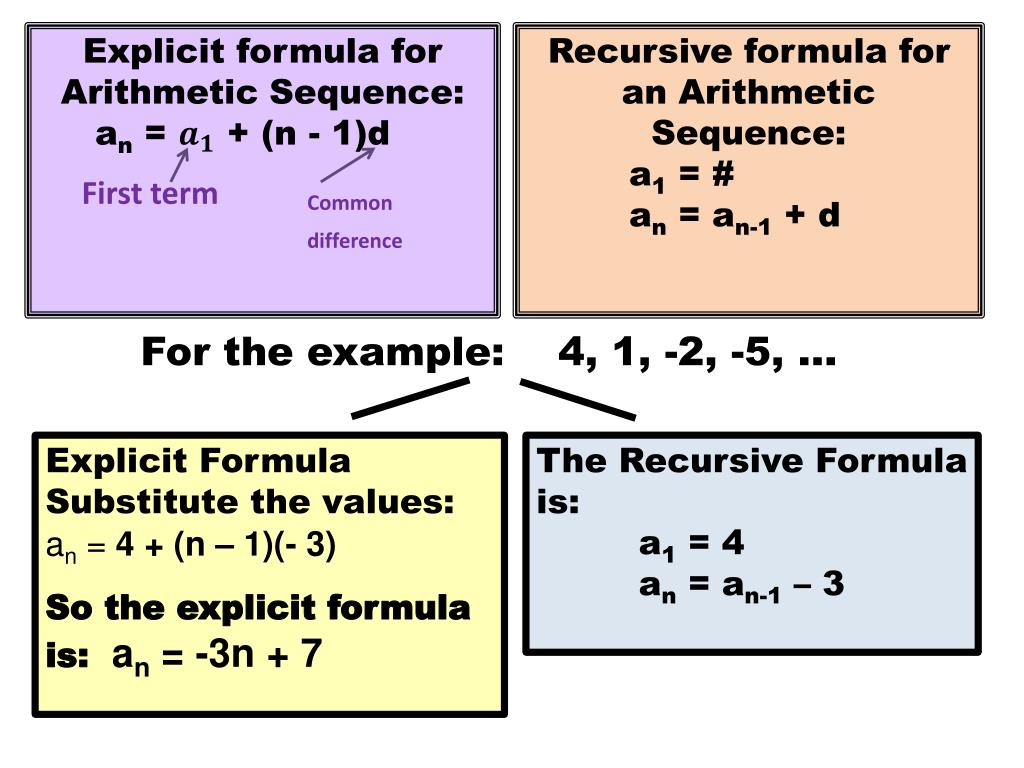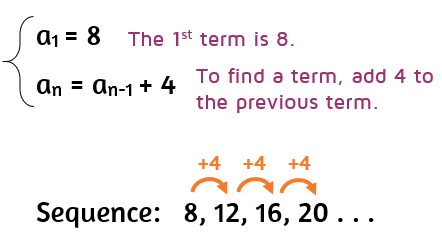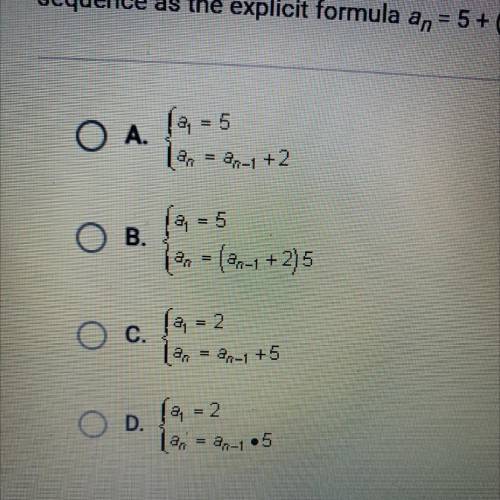

#Recursive formula for arithmetic sequence free#
I know I explained this pretty badly, feel free to ask any questions regarding this. A recursive formula allows us to find any term of an arithmetic sequence using a function of the preceding term. For the recursive formula to be complete, the first term must be defined. Example3: Solve the difference equation 9a r -6a r-1 +a. An explicit formula returns any term of a given sequence, while a recursive formula gives the next term of a given sequence. Construct the formula The formula has the form: a (n) a (n-1) + common difference, a (1. first term k - (h-1) (common difference) 3. Pick a term in the sequence, call it k and call its index h ii. $n^2+1$ numbers seems to always work (10, 17, 26, 37 etc), and I have no clue why. Solving the recurrence relation means to nd a formula to express the general term an of the sequence. The recursive formula of an arithmetic sequence is, a n a n-1 + d The recursive formula of a geometric sequence is, a n a n-1 r Here, a n represents the n th term and a n-1 represents the (n-1) th term. Figure out the common difference Pick a term in the sequence and subtract the term that comes before it. The question is, is there a mathematical way for figuring out the different numbers that can represent n that satisfies scenario z? And if n does satisfy the given scenario, is there a way to figure out x and y without having to try every possible combination? X and y has to be an integer between 0 and and n, and x cannot be equal to y Each number in that sequence represents a in the sequence. In this course we will deal with two kinds of sequences, and. LIMITS OF RECURSIVE SEQUENCES 3 Two simple examples of recursive denitions are for arithmetic sequences and geomet-ric sequences. Students will be able to write arithmetic sequences in recursive form. N can only be an integer, no decimals involved here. Students will be able to write arithmetic sequences in explicit form. Add 1+2+3+4+5+8+9+10 (don't count the numbers that were multiplied together) and we also get 42. For example, 6 and 7 (let's call 6 and 7 x and y for now) are between 1 and 10 and if multiplied together, we get 42. By this formula the n th term of an arithmetic sequence a1, a2, a3, whose common difference is ‘d’ is, anan1+da. The product should be equal to the rest of the numbers added together. The arithmetic sequence recursive formula is used to find a term of an arithmetic sequence by adding its previous term and the common difference. Pick 2 numbers in the sequence and multiply them. For sequences, a recursive formula is a formula that you have to use over and over again to come up with the terms of the sequence. Let's say we have a standard arithmetic sequence that goes up by 1 each time

However, the differences among the adjacent terms would be the same in case of the arithmetic sequence.This is going to be hard to explain so I'll just give an example The Arithmetic sequence is the sequence where each term is obtained or created by adding, subtracting the common numbers with its preceding value or terms. Here, we have that the explicit formula is a n 4 + 4 ( n 1), then the recursive formula will be a n a n 1 + 4.

The ordered list of number is named as sequence and when they are added together, it is named as the series. If the explicit formula for a sequence is a n a 1 + n ( d 1), then the recursive formula is a n a n 1 + d. Recursive formula for an arithmetic sequence: 1 +. The concept of Arithmetic was started in the year 1801 and still valid in the practical world. Remember, a sequence is just a list of numbers, usually with a pattern from one term. There are four basic operations applied to the arithmetic numbers and the advanced operations may include – logarithm values, exponential values, square roots etc.

This branch of mathematics involves the study of numbers, and the properties of the study of traditional operations like sum, difference, division, or multiplication etc. The issue is that you need a starting point, or an initial value. Arithmetic is one of the oldest elementary branches of the mathematics that is originated from the Greek word. It reads as follows: to get the next number in the sequences, add 1 to the previous number.


 0 kommentar(er)
0 kommentar(er)
